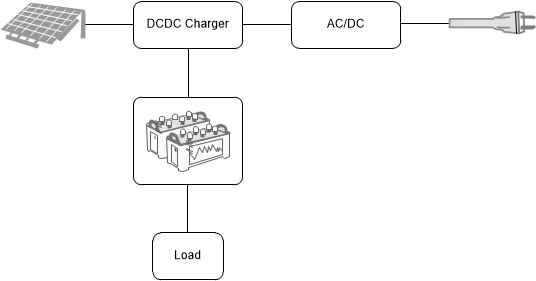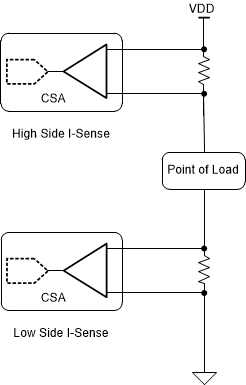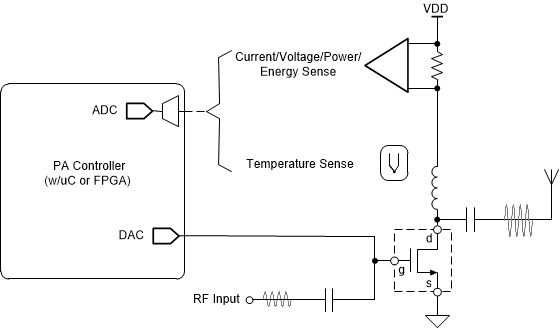SBOA366C december 2020 – august 2023 INA180 , INA190 , INA200 , INA201 , INA202 , INA225 , INA226 , INA2290 , INA233 , INA240 , INA290 , INA301 , INA310A , INA3221 , INA4180 , INA700 , INA780A , TMCS1100 , TMCS1101 , TMCS1123
In this article, a fresh look is taken into the major electronic end equipment for cellular wireless infrastructure (WI) from the perspective of current sensing (CS). Several types of CS applications in such equipment are reviewed.
Current Sensing in Power Supply Block
As shown in Figure 1, the power supply for the WI equipment comes from the utility grid, solar energy, or sometimes a combination of the two. The power supply is often backed up with battery storage for uninterrupted service during a power outage, especially in remote areas where solely depending on grid electricity is not an option due to limitations from physical accessibility or economic feasibility.
 Figure 1 WI Power Supply Block Diagram
Figure 1 WI Power Supply Block DiagramThe power supply block can be either integrated into the WI end equipment, or can be stand-alone. Regardless of the implementation, a common requirement is an intelligent power management system to charge batteries and provide seamless transitions between power sources. Current and voltage sensing is an indispensable function in such power management systems.
Current sensing can be implemented either on the high side or on the low side. Dedicated high-voltage, shunt-based, Current Sense Amplifiers (CSA) such as the INA240 or INA241A are often required for fault to ground prevention. Magnetic current sensors such as the TMCS1123 or TMCS1101 are both options for high-voltage applications due to their inherent galvanic isolation. The TMCS1123 provides ambient field rejection, fast overcurrent detection, and is capable of 75ARMS of continuous current flow perfect for incoming grid or solar power.
Current Sensing at Point Of Load
The typical WI electronic system is powered from a DC bus, such as 12 V to 48 V. Lower supply rails are derived from the bus voltage.
These lower voltage rails are called point-of-load (POL) supplies, stemming from the fact that these rails satisfy a set of specific requirements and are typically located in the vicinity of the supported loads. Depending on how critical or informative the measurements are, monitoring the current or voltage in one or more of these POL supplies is recommended. The main requirements for the CSA in this situation can include (among others) accuracy, speed, dynamic range, and power dissipation by the associated shunt resistor.
 Figure 2 Point of Load Current Sensing Options
Figure 2 Point of Load Current Sensing OptionsAs shown in Figure 2, current can be sensed at either side of the load, with analog or digital CSA, and through either external or integrated shunt resistors.
CSA comes with a matched resistor gain network that provides value in terms of cost, board space, and performance. Most CSAs feature fixed-gain, ranging from 10 to 1000. Some CSAs offer configurable gain. For example, the INA225 has configurable gain through two digital control pins, while other CSAs have a gain that is configurable through an external resistor, such as INA139.
System integration is further improved when a selected CSA that comes with integrated analog to digital conversion (ADC) and a shunt resistor. EZShunt™ Technology integrates the shunt resistor into the leadframe of the device, that generally reduces the overall form factor of the current sensing circuit. The INA700 is an ultra-small wafer chip scale digital power monitor with a 40-V common mode range and a 2-mΩ leadframe resistance, which makes the device 10ARMS capable. The INA780A is a slightly larger EZShunt™ product offered in a QFN package with a 85-V common-mode range and a 400-μΩ leadframe resistance, making the device 75ARMS capable.
The key considerations in selecting a CSA and associated shunt resistor for POL measurement starts with common-mode voltage, current range, accuracy, and speed. In addition, if overcurrent protection (OCP) is required, a CSA with an integrated fast-action comparator is often the best choice, where system parameters such as offset and propagation delay are specified. Compared with discrete components, such a CSA helps remove uncertainties and as a result, simplifies the design.
To monitor multiple POLs, a multichannel CSA such as the INA4290 or INA4180 can make sense, since these amplifiers offer four channels of analog output. When a microcontroller or FPGA is present in the equipment, an ADC channel is typically available, as well as a digital bus such as I2C. In this situation, an analog or digital output CSA can be implemented as a POL monitor. A multichannel digital monitor such as the INA3221 is another option that frees up controller ADC channels while taking advantage of an existing I2C bus. This device offers a number of warning and alert signals for fast action in case of a fault, as well as current, voltage, or power information of three independent channels.
Current Sensing in Power Amplifiers
The bias current in power amplifiers (PA) is adjusted to meet the need of an end application, modulation scheme, and operation class. A typical PA with current sensing is shown in Figure 3.
The PA is often constructed with silicon LDMOS or GaN technology. Current sensing is important in PA applications, both from the standpoint of the PA operation and from the standpoint of overall energy efficiency management. Under the same bias voltage, the PA bias current differs due to device variation. Further, the bias current changes with temperature. Consequently, for the PA controller to accurately control the bias current, both the current and temperature information must be available. The bias current information is required in improving system efficiency, where approximately 50% of total system power is consumed by the PA itself.
Integrated power amplifier monitor and control systems, such as the AMC7836, can simplify PA circuit design. As mentioned, due to natural device variation, knowing gate voltage alone is sometimes not sufficient to achieve accurate bias current control. When current sensing is required in the control loop, a separate high-voltage CSA (such as the INA290 or INA281) can be used.
Power amplifier monitor and control systems such as the AMC7834 are another option with integrated current sensing capability. Such a design offers the possibility of further reducing board space.
 Figure 3 PA
Biasing and Current Sensing
Figure 3 PA
Biasing and Current SensingAlternate Device Recommendations
TI offers a complete line of CSA and magnetic sensors that serve in WI end equipment, from high-voltage supply current and PA current sensing to general purpose POL current monitoring. The high-voltage INA310A also comes with integrated comparator and reference output to facilitate the OCP requirement. For applications where excellent accuracy is required, the INA190 family of devices are options with nA input bias current. These devices are essential in situations where the sensed current is small. Some of these devices come with Enable pins for further power reduction; some are offered in a WCSP package for board space optimization. For applications with lower common mode voltage requirements, the INA180 offers speed and overall performance value. The INA301 family of devices features integrated fast comparators and high-speed amplifiers. Both outputs that are available that meet the requirements of OCP.
Related Documentation
- Texas Instruments, Hybrid Battery Charger With Load Control for Telecom Equipment, application note.
- Texas Instruments, Precision Current Measurements on High-Voltage Power Supply Rails, application brief.
- Texas Instruments, Common Uses for Multichannel Current Monitoring